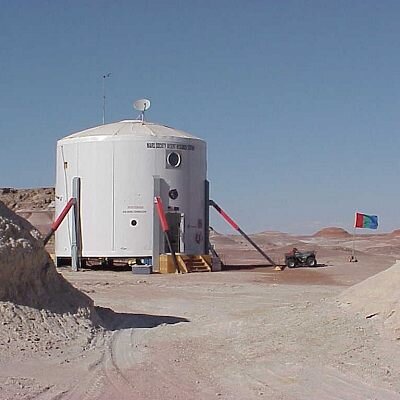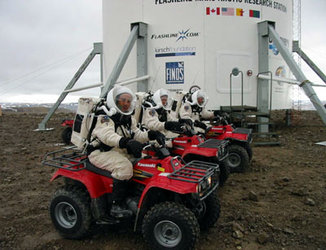Day 1: Sunday 7 April
Martian greetings, Earthlings!
This is our first day at the Mars Desert Research Station (MDRS in short). It is a fantastic place in unbelievable surroundings. The rest of the crew at the base is great.
But let me start from the beginning. Arriving here was much easier than last year in the Arctic. It only took 24 hours, door-to-door. Having left Amsterdam Saturday morning, I arrived in Atlanta 9 hours later. In Atlanta I had a two-hour wait for the connection to Salt Lake City. I was picked out at random by security for a strip search (even my shoes were examined). Another 4 hours and I was at Salt Lake City where I met the rest of crew. Bill Clancey, with whom I spent one week at the Mars Station in Devon last year and who will be our Commander for these two weeks. Andrea Fori, planetary geologist from California, was with Bill to greet me at the airport. The rest of the crew was doing the last bit of shopping for the next two weeks. Nancy Wood, a biologist from Chicago, David Real, a journalist from Dallas, and Jan Osburg, an aerospace engineer from Stuttgart, Germany. Jan was actually involved in the student competition to propose alternative redesign of the ISS at the Concurrent Design Facility in ESTEC in February this year.

The three of them filled up three supermarket trolleys with cans, vegetables, meat, etc, enough to sustain a siege for more than a month in our Mars Base. We then drove south for another four hours, and after stopping for a meal, we arrived at around 1am in Hanksville, a small village at the intersection of two roads, a place that used to be ravaged by Butch Cassidy in those western days of the 19th century. We stayed in a motel for a short night as this part of the US passed from Mountain Standard Time to Mountain Daylight Time, equivalent to what we did two weeks ago in Western Europe, which meant another hour less to sleep.
This morning we drove through the most grandiose scenery to reach our final destination for next two weeks, the MDRS research station. The surroundings are so unearthly that the well-known Hollywood film director J. Cameron came here to see whether he could shoot some scenes for one of his Sci-Fi movies.
We met the departing crew who was partly sad to leave and partly happy to go back to civilization. I guess that we will feel the same in two weeks, but for the moment we have so much ahead of us that our minds are filled with other expectations.

The departing crew explained the various little things to do and not to do. After which we had several engineering chores to perform. Luckily, Frank Schubert, the general manager of the habitat, was here with some of his engineering team to organise everything. The greenhouse door was repaired as it was blown away by strong winds in the previous days. A new generator was installed which can run uninterrupted. The outlet and leach field of the ‘biolet’ (the biological toilet that replaces the infamous incinerator toilet of the previous simulation) still needed to be sorted out. Well, yes, it is important - as we want to run this simulation in a closed environment we have to take care of these things before we actually start the simulation.
We also had a few visitors who heard about the simulation and wanted to have a look. Obligingly, we showed them around and explained that they were lucky as we would start full simulation mode by midnight tonight and that the next opportunity for external visitors wouldn’t be for two more weeks.
We then had a long discussion on how we would arrange the different duties and chores for the next two weeks. I am very impressed by the organization that Bill, our Commander, wants to bring in this simulation campaign and also by the enthusiasm and willingness of the rest of the crew. In just over three months, an enormous amount of data on the local biology, geology and of some geophysics experiments will have been collected and samples will start to accumulate in the lab on the ground floor. So we need a good archiving and labelling system so as not mix things up.
We also had the chance to ride the ‘All Terrain Vehicles’ (ATV in short) still outside the simulation mode. We were able to take in the spectacular views with all the different shades of reds, yellows and greens of the surrounding canyons and hills. Few words can describe the feeling: just out of this world!
All in all, it was an excellent two days. I met the rest of the crew with whom I would spend the next two weeks in this Hab, and we had a very nice impression of how the simulation would go from the departing crew, it was very obvious that they did not want to leave.
The jet lag has started to take its toll rather heavily. So I will sign off here for today, with a huge Martian smile on my face.
On to Mars!





